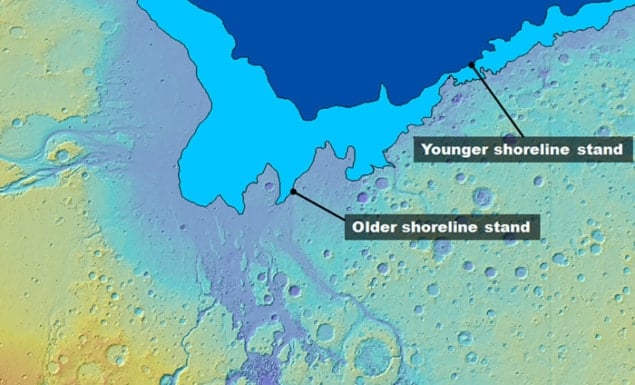
Mega-tsunamis, triggered by huge meteorite impacts, played a key role in creating and shaping the shorelines and costal terrains on early Mars, according to the latest work by an international team of researchers. Thanks to new geological mapping of the northern Martian plains, the team has identified vast sedimentary deposits that were most likely deposited by two massive tsunami events that occurred a few million years apart. According to the researchers, the gigantic waves have left indelible marks on the Martian surface and suggest that the planet once had cold, salty oceans that were conducive to life.
Geologists and planetary scientists have long thought that a large ocean existed in the northern regions of Mars, some 3.4 billion years ago. But after searching for more than 50 years, they have not been able to identify the remnant features of a shoreline along a constant elevation, making it very difficult to verify the existence of such an ocean. But thanks to new geomorphic and thermal image-mapping of the circum-Chryse and north-western Arabia Terra regions of the northern plains of Mars, Alexis Rodriguez of the Planetary Science Institute in Tucson, Arizona, and colleagues believe that huge tsunamis reshaped the early Martian landscape.
Deep impact
“Our discovery offers a simple solution to this problem; widespread tsunami deposits distributed within a wide range of elevations likely characterize the shorelines of early Martian oceans,” says Rodriguez. By combining numerical analyses with the imaging data, the researchers conclude that two meteorite impacts millions of years apart created 30 km-wide marine impact craters. Such events could have generated onshore waves that were nearly 120 m high and which moved several hundred kilometres inland.
“About 3.4 billion years ago, a big meteorite impact triggered the first tsunami wave. This wave was composed of liquid water. It formed widespread backwash channels to carry the water back to the ocean,” says team member Alberto Fairén, who is currently a visiting scientist at Cornell University in the US.
The team’s analyses also suggested that within the early Martian ocean, impact craters of this size were formed every three million years. But during the intervening millions of years, Mars went through a frigid climate change, when water turned to ice. “The ocean level receded from its original shoreline to form a secondary shoreline, because the climate had become significantly colder,” says Fairén. Evidence for such a climate change is reflected in the morphology of the tsunami deposits. The older tsunami left behind “enormous boulder-rich deposits, and as the wave retreated back into the ocean it formed widespread backwash channels”, according to Rodriguez.
Icy flows
In contrast, the younger tsunami’s sediments were mainly made up of rounded lobes of ice, thanks to the climate. “These lobes froze on the land as they reached their maximum extent and the ice never went back to the ocean – which implies the ocean was at least partially frozen at that time,” explains Fairén, adding that the team’s work provides solid evidence for the existence of very cold oceans on early Mars. “It is difficult to imagine Californian beaches on ancient Mars, but try to picture the Great Lakes on a particularly cold and long winter, and that could be a more accurate image of water forming seas and oceans on ancient Mars,” he adds.
As these icy lobes have still retained their well-defined boundaries and their flow-related shapes, it follows that the ancient ocean was briny. “Cold, salty waters may offer a refuge for life in extreme environments, because the salts could help to keep the water liquid. If life existed on Mars, these icy tsunami lobes are very good candidates to search for biosignatures,” says Fairén.
Indeed, these long-lasting lobes still retain much of the original deposits and could tell us more about the ancient ocean’s composition. Rodriguez points out that sampling these materials is crucial and could be a key target for future robotic Mars landers or even human missions. But he also adds that because the materials are relatively close to the Mars Pathfinder landing site, our current technology could have tested them too.
The researchers have also identified some areas inundated by the tsunamis where the water seems to contain lacustrine (fluvial) sediments, including “evaporates” (water-soluble mineral sediments). They plan to characterize these terrains and assess their potential for future exploration.
The research is published in Scientific Reports.



